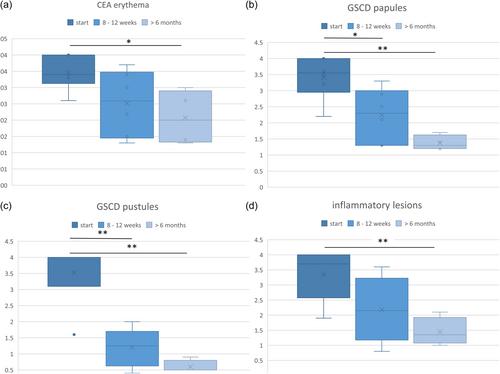Rosacea fulminans: An anti-inflammatory-based therapeutic approach
Abstract
Background
The treatment of rosacea fulminans still poses a significant challenge in daily clinical practice. The pronounced centrofacial inflammation accompanied by severe pustulation, pain and high psychological stress, mostly affecting young women, requires an appropriate fast-acting treatment regimen. A major difficulty here is that if isotretinoin is recommended for therapy, sufficiently reliable contraception is absolutely necessary and not always given. So far, alternative therapies have not been extensively studied.
Objectives
Our goal is to show the efficacy of a treatment regimen with macrolide antibiotics (azithromycin) without the need for initial systemic isotretinoin or corticosteroids.
Methods
We present six female patients in our outpatient clinic treated with a combination of azithromycin and topical ivermectin reaching rapid inflammation control.
Subsequently, maintenance with ultra-low dose isotretinoin was initiated in 66% of cases. The patients were monitored for a median follow-up time of 15.5 months [1–51 months].
Results
We can show rapid improvement of inflammation under antibiotic-treatment with azithromycin (500 mg 3x weekly for 4 weeks, 2x weekly for 4 weeks, 1x weekly 4 weeks) followed by ultra-low dose isotretinoin maintenance treatment with minimal side effects. Topical ivermectin was administered additionally.
Conclusions
Macrolides, in particular azithromycin, pose an alternative treatment method when retinoids are contraindicated extending the treatment regimen of rosacea fulminans. They are a fast-acting and safe alternative to retinoids without the need for initial contraception. The antibiotic-based approach is particularly suited to the control of inflammation.


 求助内容:
求助内容: 应助结果提醒方式:
应助结果提醒方式:


